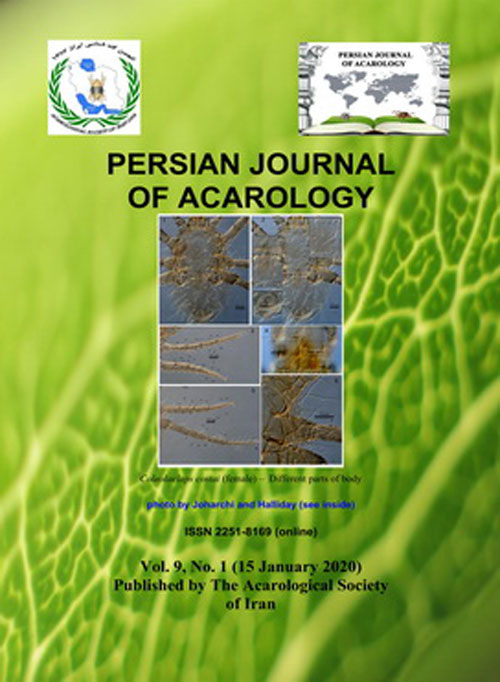فهرست مطالب

Persian Journal of Acarology
Volume:9 Issue: 1, Winter 2020
- تاریخ انتشار: 1398/11/14
- تعداد عناوین: 9
-
-
Pages 1-11
This study is based on freshwater halacarid mites collected from two different provinces (Isparta and Muğla) of Turkey. Limnohalacarus wackeri (Walter, 1914) and Soldanellonyx monardi Walter, 1919 are reported for the first time for Turkish freshwater halacarid fauna. Additionally, both nymphal stages of Halacarellus hyrcanus (Viets, 1928) and deutonymph of Porohalacarus alpinus (Thor, 1910) are also recorded for the first time for Lake Eğirdir, Isparta. Each species is illustrated, briefly diagnosed with notes and shown on a map of Turkey depicting all recorded freshwater halacarid species to this date.
Keywords: Biogeography, Halacaroidea, new records, nymphs, taxonomy -
Pages 13-21
Until now, Favognathus insularis (Luxton, 1973) has been only known from the Niue Island. In recent surveys conducted in the Brazilian state of São Paulo, a second record of this species was provided. It is redescribed here based on the adult females. Also, an identification key to known species of Favognathus is provided.
Keywords: New record, Prostigmata, Raphignathoidea, predatory mites, soil -
Pages 23-42
This study provides additional morphological information and new illustrations for 13 species of soil mites in the family Laelapidae previously described from Iran, to supplement the original descriptions.
Keywords: Coleolaelaps, Gaeolaelaps, Hypoaspis, Laelaspis, Myrmozercon, Promacrolaelaps -
Pages 43-56
The two-spotted spider mite, Tetranychus urticae Koch is one of the most important pests of strawberry plants worldwide. The present study compared the biology and life table parameters of T. urticae on four strawberry cultivars, including Wanter star, Markez, Fortona and 029 under laboratory conditions. Female developmental times showed a significant difference when recorded on tested cultivars, while such a difference was not observed for the male ones. The developmental time was significantly longer on Wanter star and Fortona in comparison with the others (P = 0.00). Females of T. urticae exhibited the shortest oviposition period and adult longevity on Fortona and Wanter star, while having the longest periods on 029 in this report (P = 0.00). The lowest fecundity and daily eggs laid by females were recorded on Wanter star. The highest rate of fertility was recorded on 029 as compared to other cultivars; therefore, Wanter star is introduced as a resistant cultivar against T. urticae infestation.
Keywords: Acari, life history, Rosaceae, Tetranychoidea, Two-spotted spider mite -
Pages 57-66
Sugarcane (interspecific hybrids of Saccharum) is a strategically important cash crop that has an economic and social impact in many countries. Sugarcane mite, Oligonychus sacchari is one of the most detrimental arthropod pests associated with sugarcane during summer. Control of this pest is mainly based on chemical pesticides and cultural practices as well as the application of silicon as a nutritional component of an integrated crop management. In this study, effects of silicon were evaluated on O. sacchari. Experiments were carried out during 2014–2015 and 2015– 2016 at Salman Farsi Agro Industry Farms, Ahwaz-Iran. The two varieties (CP57-614 and CP48-103) were treated by silicic acid fertilizer as foliar application. Five treatments including one spray (0.5 lit/ha), two sprays (0.5 and 1 lit/ha 3 weeks after spray 1), three sprays (0.5, 1 and 1 lit/ha 4 weeks after spray 2), four sprays (0.5, 1, 1 and 1 lit/ha 4 weeks after spray 3) and Control were applied. In each plot, 15 leaves were randomly selected from bottom, mid and top of plant and number of living mites and dry leaves were recorded. Samples were collected 7, 14, 21 and 28 days after the forth application of silicic acid. The results showed that all treatments had significant effects in mite population and leaf dryness versus Control. Among different treatments of silicic acid, four spray application of silicic acid was more efficient than other treatments on mite damage and leaf dryness. It seems that the silicic acid would be a promising product for management of mite damage and could be incorporated with other management strategies in sugarcane IPM.
Keywords: Ladybird, mite damage, mortality, silicon, sugarcane IPM -
Pages 67-81
Essential oils are environmentally benign agents which are used as alternative compounds for chemical pesticides in order to control pests. Thus, in the current study, the toxicity and repellency effects of essential oils, extracted from three medicinal plants of the Lamiaceae family, including Thymus daenensis, Satureja khuzestanica, and S. bakhtiarica, were evaluated against a resistant (MhR) and a susceptible (KrS) population of Tetranychus urticae. Results based on probit analysis revealed that all extracted essential oils to some extent showed both repellency and toxicity effects on both populations of the mite. The LC50 values of S. khuzestanica extract were the lowest against the both populations (31.16 µL. L−1 air for KrS population and 56.29 µL. L−1 air for MhR population). Also, all extracted essential oils were found to be repellent to the adult females of both MhR and KrS populations, with higher repellency effect of S. khuzestanica oil. The effect of the LC20 of the essential oils on detoxifying enzymes including Glutathione S-transferases (GSTs), esterases (ESTs) and cytochrome P450 monooxygenases (P450) was tested against both populations. Significant higher activity of all enzymes was detected in MhR population regardless of essential oils treatment. The activity of GSTs and esterases increased significantly in mites treated with all essential oils, while a tendency for a decrease in P450 activity was detected following essential oils treatment. These results indicate that the essential oils of the all selected plants, especially S. khuzestanica, have a good potential to be used in integrated management programs of T. urticae which is a serious pest in the greenhouses.
Keywords: Detoxification enzymes, IPM, Satureja bakhtiarica, S. khuzestanica, Thymus daenensis, Two-spotted spider mite

